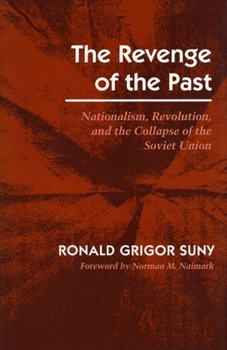Revenge of the Past: Nationalism, Revolution, and the Collapse of the Soviet Union
Select Format
Select Condition 
Book Overview
This timely work shows how and why the dramatic collapse of the Soviet Union was caused in large part by nationalism. Unified in their hostility to the Kremlin's authority, the fifteen constituent Union Republics, including the Russian Republic, declared their sovereignty and began to build state institutions of their own. The book has a dual purpose. The first is to explore the formation of nations within the Soviet Union, the policies of the...
Format:Paperback
Language:English
ISBN:0804722471
ISBN13:9780804722476
Release Date:December 1993
Publisher:Stanford University Press
Length:224 Pages
Weight:0.60 lbs.
Dimensions:0.5" x 5.5" x 8.5"
Customer Reviews
1 rating
USSR dug its own grave by its incubation of smaller nations
Published by Thriftbooks.com User , 21 years ago
Suny stresses the development and creation of nationalism within the Soviet Union as the main cause of its collapse. This nationalism, he states, is built on common interests, imagined communities (loaned from Benedict Anderson), rituals, symbols, flags, songs, collective events and the expression of goals.Suny describes how, especially under Lenin, the development of nationalism was encouraged the Soviet Union. It was this naïve trust in the institutionalization of previously non-existent nationalism within the Soviet Union which lead to inner conflict and desire for the new nations to break free from the Diets, from Russia's rule.Suny points out that nationalism and nationality are not artificial by blending his moderately constructivst view on nationalism with the suggestion that nationalities might be rooted in "ethnies" (Anthony D. Smith's term). Suny also contributes war with the strengthening of the nation.In the book he describes clearly the reasons to why regions in the Soviet Union became independent nations and why this process occured on different terms in these different areas. The nations he pedagogically discusses are Finland, Estonia, Latvia, Lithuania, Ukraine, Belarus, Georgia, Armenia and Azerbaijan.In part the author contributes the short-sightedness of the Russian policy of building nations to the failure of Marxists in the 19th and early 20th century to realize the importance of nationalism. Ethnicity and class were not obliterated in the Soviet Union and it remained an empire open mostly for Russians and Slavs. In Caucasus the local peoples were constantly kicked around by the Soviet Union and surrounding empires. In Azerbaijanis' capital, Baku, the Azerbaijan's were marginalized by the influx of skilled-workers (mostly from Northern lands).Eventually due to Stalin's strangle-hold; the following "thaw" under Chruschev, Breshnev, Chernko; due to Gorbachev's bumbling and the intiative of Russian satellite states; the aforementioned nine nations broke free from the retarding Russian rule and became independent nations.This book provides an interesting perspective on the development of nations and nationlism and their seeming inevitability in a world ruled by such things such as democracy, capitalism, class and race. Suny has written this book in an orderly fashion and covered in detail the specific nations and the struggles within. However, this book is lacking many details in the effort to depict the downfall of the Soviet Union from a somewhat tenuous perspective that favors political ideology and momentum of specific classes as the sole firebrands of revolution.





